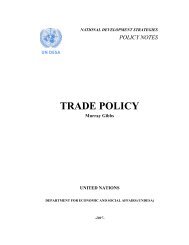Guidelines on the Safe Use of Urine and Faeces in ... - EcoSanRes
Guidelines on the Safe Use of Urine and Faeces in ... - EcoSanRes
Guidelines on the Safe Use of Urine and Faeces in ... - EcoSanRes
Create successful ePaper yourself
Turn your PDF publications into a flip-book with our unique Google optimized e-Paper software.
Carol<strong>in</strong>e Schönn<strong>in</strong>g <strong>and</strong> Thor Axel Stenström<br />
THE POSSIBLE USE OF A TREATMENT INDICATOR<br />
A st<strong>and</strong>ard analytical measure, i.e. an <strong>in</strong>dicator organism, to c<strong>on</strong>trol <strong>the</strong> “producti<strong>on</strong>” <strong>of</strong> a<br />
safe fertilizer product would be <strong>the</strong> ideal situati<strong>on</strong> but is not regarded as a viable opti<strong>on</strong> due to<br />
various c<strong>on</strong>stra<strong>in</strong>ts. Detailed recommendati<strong>on</strong>s <strong>on</strong> how to safely manage a sanitati<strong>on</strong> system<br />
<strong>in</strong>clud<strong>in</strong>g use <strong>of</strong> faeces <strong>and</strong> ur<strong>in</strong>e may <strong>the</strong>refore be more valuable. Suitable c<strong>and</strong>idates exist,<br />
represent<strong>in</strong>g <strong>the</strong> most resistant organisms <strong>in</strong> <strong>the</strong> groups <strong>of</strong> bacteria, viruses, parasitic protozoa<br />
<strong>and</strong> helm<strong>in</strong>ths. These can be used as c<strong>on</strong>servative <strong>in</strong>dex organisms for validati<strong>on</strong> <strong>of</strong> different<br />
treatment opti<strong>on</strong>s <strong>in</strong> challenge experiments. The enterococci, selected bacteriophages,<br />
Cryptosporidium oocysts <strong>and</strong> Ascaris eggs may functi<strong>on</strong> as such <strong>in</strong>dex organisms.<br />
For faeces (or excreta, i.e. faeces <strong>and</strong> ur<strong>in</strong>e mixed), <strong>the</strong> Engelberg guidel<strong>in</strong>es (stated <strong>in</strong> WHO,<br />
1989) for nematode eggs <strong>and</strong> faecal coliforms have prior been <strong>in</strong> focus, even though it is stated<br />
that <strong>the</strong>se are not <strong>in</strong>tended as st<strong>and</strong>ards for quality surveillance but ra<strong>the</strong>r as design goals<br />
for treatment systems. Problems with quality c<strong>on</strong>trol <strong>in</strong>clude costs, lack <strong>of</strong> local laboratory<br />
capacity <strong>and</strong> <strong>the</strong> lack <strong>of</strong> rout<strong>in</strong>e methods for <strong>in</strong>dicators or specific pathogens that could<br />
represent various groups <strong>of</strong> pathogens. Thermotolerant (faecal) coliforms are still widely used<br />
even though it has been questi<strong>on</strong>ed how representative <strong>the</strong>y are <strong>of</strong> <strong>the</strong> pathogens <strong>of</strong> c<strong>on</strong>cern.<br />
In ur<strong>in</strong>e, <strong>the</strong> comm<strong>on</strong>ly used faecal <strong>in</strong>dicator organism E. coli is unsuitable due to its rapid<br />
<strong>in</strong>activati<strong>on</strong>, which does not mimic <strong>the</strong> die-<strong>of</strong>f <strong>of</strong> different pathogens. Enterococci (faecal<br />
streptococci) <strong>on</strong> <strong>the</strong> o<strong>the</strong>r h<strong>and</strong> were shown to grow with<strong>in</strong> <strong>the</strong> ur<strong>in</strong>e-pip<strong>in</strong>g system <strong>and</strong> may<br />
<strong>the</strong>refore give false positive results <strong>in</strong> <strong>the</strong> predicti<strong>on</strong> <strong>of</strong> faecal c<strong>on</strong>tam<strong>in</strong>ati<strong>on</strong>. It had a slower<br />
reducti<strong>on</strong> <strong>and</strong> can thus be used as a predictor <strong>of</strong> storage efficiency. Nei<strong>the</strong>r <strong>of</strong> <strong>the</strong>se two<br />
<strong>in</strong>dicators is however suitable to use for predict<strong>in</strong>g <strong>the</strong> degree <strong>of</strong> faecal c<strong>on</strong>tam<strong>in</strong>ati<strong>on</strong> <strong>and</strong><br />
associated risks. The search for specific pathogens <strong>in</strong> ur<strong>in</strong>e is time c<strong>on</strong>sum<strong>in</strong>g <strong>and</strong> expensive.<br />
Instead an assumed faecal c<strong>on</strong>tam<strong>in</strong>ati<strong>on</strong> can be<br />
used as a predictor for prescribed storage times<br />
<strong>and</strong> subsequent time between fertilizati<strong>on</strong> <strong>and</strong><br />
harvest.<br />
Results from mesophilic compost<strong>in</strong>g<br />
(Holmqvist & Stenström, 2001) imply that <strong>the</strong><br />
<strong>in</strong>dicators E. coli <strong>and</strong> enterococci were not suitable<br />
for this type <strong>of</strong> process s<strong>in</strong>ce <strong>the</strong>ir <strong>in</strong>activati<strong>on</strong><br />
was so much faster than for viruses <strong>and</strong> Ascaris<br />
eggs. Even if many regulati<strong>on</strong>s for treatment<br />
<strong>of</strong> sewage sludge <strong>and</strong> food waste are based <strong>on</strong><br />
E. coli <strong>and</strong> Salm<strong>on</strong>ella as quality <strong>in</strong>dicators,<br />
a m<strong>on</strong>itor<strong>in</strong>g <strong>of</strong> <strong>the</strong> process parameters (e.g.<br />
temperature) is more relevant <strong>and</strong> c<strong>on</strong>sidered<br />
as <strong>the</strong> ma<strong>in</strong> c<strong>on</strong>trol. If <strong>in</strong>cluded for m<strong>on</strong>itor<strong>in</strong>g<br />
purposes, <strong>the</strong>se two <strong>in</strong>dicators should be related<br />
to risk <strong>of</strong> regrowth dur<strong>in</strong>g subsequent h<strong>and</strong>l<strong>in</strong>g<br />
<strong>of</strong> <strong>the</strong> materials.<br />
Figure 17. Elevated ur<strong>in</strong>e-separat<strong>in</strong>g toilet <strong>in</strong><br />
Vietnam<br />
28

















